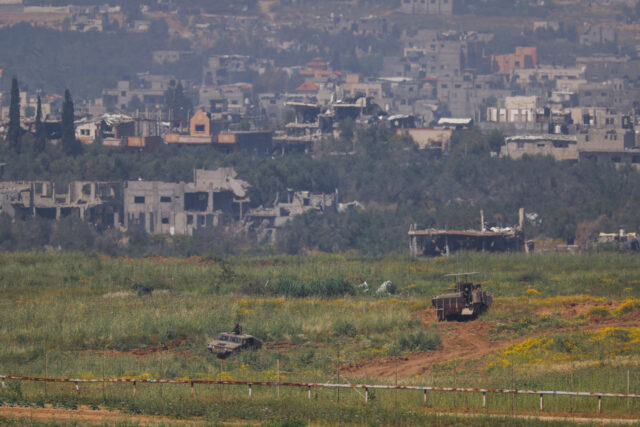As the Israel-Hamas war nears six months, here’s a throwback to the troubled past of Gaza and how the Israel-Palestine conflict has played over the years.
1948: End Of British Rule
As British colonial rule came to an end in Palestine in the late 1940s, violence intensified between Jews and Arabs, culminating in war between the newly created State of Israel and its Arab neighbours in May 1948.
Thousands of Palestinians took refuge in Gaza after fleeing or being driven from their homes in a mass displacement known by Palestinians as “Nakba”, meaning “catastrophe” in Arabic. The invading Egyptian army had seized a narrow coastal strip 25 miles long, which ran from the Sinai to just south of Ashkelon. The influx of refugees saw Gaza’s population triple to around 200,000.
1950s & 1960s: Egyptian Military Rule
Egypt held the Gaza Strip for two decades under a military governor, allowing Palestinians to work and study in Egypt. Armed Palestinian ‘fidayeen’, many of them refugees, mounted attacks into Israel, drawing reprisals. The United Nations set up a refugee agency, UNRWA, which today provides services for 1.6 million registered Palestine refugees in Gaza, as well as for Palestinians in Jordan, Lebanon, Syria, and the West Bank.
1967: War And Israeli Military Occupation
Israel captured the Gaza Strip in the 1967 war. An Israeli census that year put Gaza’s population at 394,000, at least 60% of them refugees.
With the Egyptians gone, many Gazans took jobs in the agriculture, construction and services industries inside Israel, to which they could gain easy access at that time. Israeli troops remained to administer the territory and to guard the settlements that Israel built in the following decades. These became a source of growing Palestinian resentment.
1987: First Palestinian Uprising; Hamas Formed
Twenty years after the 1967 war, Palestinians launched their first intifada or uprising. It began in December 1987 after a traffic accident in which an Israeli truck crashed into a vehicle carrying Palestinian workers in Gaza’s Jabalya refugee camp, killing four. Stone-throwing protests, strikes and shutdowns followed.
Seizing the angry mood, the Egypt-based Muslim Brotherhood created an armed Palestinian branch, Hamas, with its power base in Gaza. Hamas, dedicated to Israel’s destruction and restoration of Islamic rule in what it saw as occupied Palestine, became a rival to Yasser Arafat’s secular Fatah party that led the Palestine Liberation Organization.
1993: The Oslo Accords And Palestinian Semi-autonomy
Israel and the Palestinians signed a peace accord in 1993 that led to the creation of the Palestinian Authority.
Under the interim deal, Palestinians were first given limited control in Gaza, and Jericho in the West Bank. Arafat returned to Gaza after decades in exile.
The Oslo process gave the Palestinian Authority some autonomy and envisaged statehood after five years. But that never happened. Israel accused the Palestinians of reneging on security agreements and Palestinians were angered by continued Israeli settlement building.
Hamas and Islamic Jihad carried out bombings to derail the peace process, leading Israel to impose more restrictions on movement of Palestinians out of Gaza. Hamas also picked up on growing Palestinian criticisms of corruption, nepotism and economic mismanagement by Arafat’s inner circle.
2000: Second Palestinian Intifada
In 2000, Israeli-Palestinian relations sank to a new low with the outbreak of the second Palestinian intifada. It ushered in a period of suicide bombings and shooting attacks by Palestinians, and Israeli airstrikes, demolitions, no-go zones and curfews.
One casualty was Gaza International Airport, a symbol of thwarted Palestinian hopes for economic independence and the Palestinians’ only direct link to the outside world that was not controlled by Israel or Egypt. Opened in 1998, it was deemed a security threat by Israel which destroyed its radar antenna and runway a few months after the 9/11 attacks on the United States.
Another casualty was Gaza’s fishing industry, a source of income for tens of thousands. Gaza’s fishing zone was reduced by Israel, a restriction it said was necessary to stop boats smuggling weapons.
2005: Israel Evacuates Its Gaza Settlements
In August 2005 Israel evacuated its troops and settlers from Gaza, which was by then completely fenced off from the outside world by Israel.
Palestinians tore down the abandoned buildings and infrastructure for scrap. The settlements’ removal led to greater freedom of movement within Gaza, and a “tunnel economy” boomed as armed groups, smugglers and entrepreneurs quickly dug scores of tunnels into Egypt. The pullout also removed settlement factories, greenhouses and workshops that had employed some Gazans.
2006: Isolation Under Hamas
In 2006, Hamas scored a surprise victory in Palestinian parliamentary elections and seized full control of Gaza, overthrowing forces loyal to Arafat’s successor Mahmoud Abbas.
Much of the international community cut aid to the Palestinians in Hamas-controlled areas because they saw Hamas as a terrorist organisation.
Israel stopped tens of thousands of Palestinian workers from entering the country, cutting off an important source of income.
Israeli air strikes crippled Gaza’s only electrical power plant, causing widespread blackouts. Citing security concerns, Israel and Egypt also imposed tighter restrictions on the movement of people and goods through the Gaza crossings.
Ambitious Hamas plans to refocus Gaza’s economy away from Israel foundered before they even started.
Viewing Hamas as a threat, Egypt’s military-backed leader Abdel Fattah al-Sisi, who took power in 2014, closed the border with Gaza and blew up most of the tunnels. Once again isolated, Gaza’s economy went into reverse.
October 2023: Surprise attack
On October7 last year, Hamas gunmen made a surprise cross-border assault on Israel by air, land and sea in which they overwhelmed Israel’s border forces and rampaged through towns, kibbutzim and military bases, killing around 1,200 people and taking around 250 hostages back to Gaza.
Israel hammered Gaza with its heaviest-ever air and artillery strikes and later launched a ground invasion and placing Gaza under blockade in what it said was an effort to destroy Hamas.
Israel instructed Palestinian civilians to move south as its forces tried to clear Hamas from northern Gaza first. Israeli troops fought battles with Hamas and other Palestinian militant groups, with Hamas operating from the ruins and an extensive network of tunnels it had built under Gaza.
Israel accused Hamas of hiding its military infrastructure beneath civilian buildings to use the population of Gaza as human shields. Palestinians and their supporters accused Israel of using disproportionate force. Both sides denied the others’ accusations.
There was a brief truce in November during which aid supplies entered Gaza and Hamas released some hostages but hostilities resumed.
Gaza’s health ministry says more than 33,000 Palestinians have so far been killed in the Israeli offensive. Israel says 256 of its soldiers had been killed in Gaza.
With inputs from Reuters
At six feet and over, cool, calm and always collected. Never a hair out of place. He is the high priest of editorial facts, grammar is his baby and headlines are meat on the bone. Loves samosas and cricket, tracks Twitter and when in his cups, nothing better than Jagjit Singh’s ghazals.





